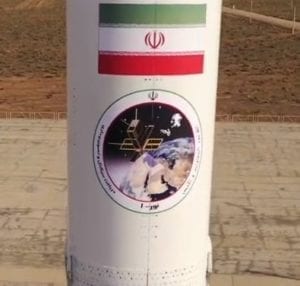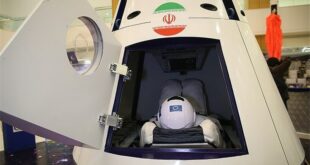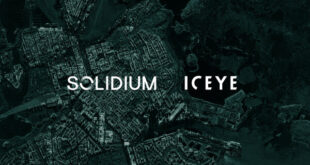
On 22 April 2020 Iran’s Islamic Revolutionary Guard Corps (IRGC) successfully launched a small satellite – the Noor-1 (Farsi for ‘Light’) – on a previously unseen satellite launch vehicle called the Qased. Over the course of this week SpaceWatch.Global is running a series of perspectives on the strategic, political, and geopolitical implications of the launch for Iran, the Middle East region, Europe, and the United States. Today’s perspectives come courtesy of Dr. Afshon Ostovar, a leading authority on the IRGC, of the Naval Postgraduate School in California, United States (below), and Dr. Aniseh Bassiri Tabrizi, Research Fellow at the Royal United Services Institute (RUSI) in London, United Kingdom (see here).
What are the strategic implications of the launch for Middle East security?
The launch will certainly increase Iran’s tensions with its neighbors, as well as reinforce the logic behind US-imposed sanctions. This will further the continued securitization of the region as neighboring states build up their forces and invest in ever more sophisticated capabilities in an effort to curb or match Iran’s advances. Beyond that, the successful launch of a military satellite might open up a new era in Iran’s defense capabilities. Were Iran to eventually place surveillance and imaging satellites into orbit, it could develop one of the most sophisticated security information networks in the region. How Iran’s neighbors respond to the launch and assess what it means for the future will also be important to watch. Launches such as this threaten to increase the proliferation of ballistic missile technology as states such as Saudi Arabia aim to catch up with Iran.
What, in your opinion, motivated the IRGC to carry out the satellite launch given current tensions with the US, as well as Iranian domestic problems with the pandemic and economy, and setbacks such as the Ukrainian airliner shootdown and the killing of General Qassem Suleimani?
Well, you’ve partly answered the question already. There is some reason to believe that the IRGC used the launch as a way to both symbolically push back against the United States and to move the news cycle beyond Iran’s current doldrums and the IRGC’s own missteps. Both narratives play well in Iran’s domestic media and the western press, but I’m doubtful that it will do much to improve perceptions of the IRGC among everyday people in Iran. The regime’s mismanagement of the country and continual lack of accountability, such as regarding the downing of Ukraine Airlines flight 752 and its aftermath, is not going to be forgotten because the IRGC now has some sort of satellite in orbit. More than anything, this launch was for the IRGC itself. It is something that will instill pride in the organization and within the regime. It will feed into the IRGC’s propaganda, and will be advanced as another marker of the continued success of its self-reliance strategy.
There is some desire by both the IRGC, and within western media, to paint the launch as a direct if unintended result of the Trump administration’s maximum pressure campaign against Iran. There is no doubt that the current context is part of the story. But I suspect that this has long been an aim of the IRGC, and they would have tested their SLV at some point even if the US had not left the nuclear deal (also known as the Joint Comprehensive Plan of Action, or JCPOA). The IRGC never considered missile tests to be a part of the larger JCPOA to begin with, even though the Obama administration certainly did. It’s a fiction to believe that the IRGC would have refrained from advancing their missile and space programs under the JCOPA. The IRGC showed no signs of abating tests after the deal was signed, and it is doubtful that they ever seriously considered slowing the pace of their activities.
Why do you think the IRGC has created its own Space Command?
The IRGC is above all Iran’s main strategic force. Anything being developed in the country that touches on strategic capabilities, the IRGC will have a hand in it. It was long suspected that the IRGC was involved in the Iran’s civilian space program at the outset, but by later setting up their own space agency, the IRGC was able to take partial ownership of a major strategic program, and ensure that the technology developed would have primary or secondary defense potentialities. There’s also an undeniable prestige factor which is also meaningful for the IRGC. The space and nuclear fields are generally perceived as the rarified territory of great powers, and the IRGC has associated itself with both.
How will the IRGC politically benefit in Iran as a result of the successful satellite launch?
The main political benefit to the IRGC will be within the regime, and in the propaganda war with the Iran’s adversaries. The IRGC will be able to cast itself to Iran’s ruling cadre and to the outside world, as a dynamic organization that cannot be stopped from accomplishing its goals. No matter the amount of foreign pressure or domestic challenges, the IRGC perseveres and succeeds. Even as the United States has turned up the pressure on Iran, the IRGC hasn’t slowed down, and has continued to act boldly and win. The semi-official Iranian press is already advancing this storyline, and the western press has advanced similar versions of this narrative as well. But although it makes for good headlines, I don’t think the IRGC’s propaganda matters much internally in Iran, nor does it contribute much to a sense of patriotism within the country. At the end of the day, the IRGC’s Space Launch Vehicle isn’t going to help normal Iranians find a job, pay rent, get married, or take care of their loved ones. The IRGC’s “victories” have come at the cost of Iran’s continued international isolation, economic decline, and estrangement from its neighbors. That tradeoff is probably not lost on the Iranian people.
In your opinion, how should other countries respond, if at all, to the IRGC space programme?
I think the main issue here is to isolate those aspects of the space program that have security dimensions, and those that have a potential dual-use for the ballistic missile program. Specifically, the IRGC’s intentions to test a solid-fuel engine is concerning. Even if tested as part of a future SLV, such an engine could also be used to advance the IRGC’s ballistic missile program. Other countries have transformed solid-fuel SLVs into long-range missiles in the past, and the IRGC might have similar plans. The international community has a broad motivation to discourage Iran from developing long-range ballistic missiles and should also be concerned with limiting the development of the IRGC’s current missile program. The IRGC is steadily making progress toward developing an intercontinental ballistic missile, and April’s successful SLV launch might be one more step in that effort. It should be a warning sign to the rest of the world. Iran’s ballistic missile program is a real problem, and one that should be taken as seriously by the international community and as Iran’s nuclear program.

Afshon Ostovar is assistant professor at the Naval Postgraduate School, and a Robert A. Fox Fellow at the Foreign Policy Research Institute. He is the author of the award-winning winning book, Vanguard of the Imam: Religion, Politics, and Iran’s Revolutionary Guards, as well as numerous other works on security and strategy concerning the Middle East.
The views expressed here by Dr. Ostovar are his own and do not necessarily reflect the views of the Naval Postgraduate School, US Navy, US Department of Defense, or the US Government.
 SpaceWatch.Global An independent perspective on space
SpaceWatch.Global An independent perspective on space




